Complete Solutions to JEE Main And Advanced of chapter RAY AND WAVE OPTICS of Class 12 book with complete answers and questions
| Class 12 | PHYSICS |
| Chapter | RAY AND WAVE OPTICS |
| SUNIL BATRA | JEE Main And Advanced |
| Number Of Questions | 100 |
| Academic Year | 2023-24 |
A light wave of frequency `5xx10^14 Hz` enters a medium of refractive index `1.5`. In the velocity of the light wave is ….. And its wavelength is ……
View SolutionA convex lens A of focal length `20 cm` and a concave lens B of focal length `5 cm` are kept along the same axis with a distance d between them. If a parallel beam of light falling on A and B as a parallel beam, then d is equal to ……cm
View SolutionA monochromatic beam of light of wavelength `6000 A` in vacuum enters a medium of refractive index `1.5`. In the medium its wavelength is…., its frequency is…..
View SolutionIn Young's double-slit experiment, the two slits act as coherent sources of equal amplitude `A` and of wavelength `lamda`. In another experiment with the same set-up the two slits are sources of equal amplitude `A ` and wavelength `lamda`, but are incoherent. The ratio of the intensity of light at the midpoint of the screen in the first case to that in the second case is....
View SolutionA thin lens of refractive index `1.5` has focal length of `15 cm` in air. When the lens is placed is a medium of refractive index (4)/(3), its focal length will become …..cm.
View SolutionA point source emits sound equally in all directions in a non-absorbing medium. Two points `P` and `Q` are at the distance of `9 meters` and 25 meters respectively from the source. The ratio of amplitudes of the waves at `P` and `Q` is…..
View Solution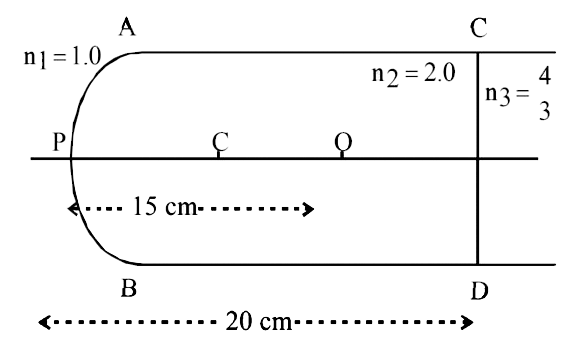
A slab of a material of refractive index 2 shown in fig. has a curved surface APB of radius of curvature 10 cm and a plane surface CD. On the left of APB is air and on the right CD is water with refractive indices as given in the figure. An object O is placed at a distance of 15 cm from the pole P as shown. The distance of the final image of O from P, as viewed from the left is......
View SolutionA thin rod of length`(f)/(3)`is placed along the optic axis of a concave mirror of focal length f such that its image which is real and elongated, just touches the rod. The magnification is …..
View SolutionA ray of light undergoes deviation of 30degree when incident on an equilateral prism of refractive index `sqrt2`. The angle made by the ray inside the prism with the base of the prism is …..
View SolutionThe resolving power of electron microscope is higher that that of an optical microscope because the wavelength of electrons is ……. Than the wavelength of visible light.
View SolutionIf `epsilon_0` and `mu_o` are, respectively, the electric permittivity and magnetic permeability of free space, `epsilon` and `mu` the corresponding quantities in a medium, the index of refraction of the medium in terms of the above parameters is….
View SolutionA light of wavelength `6000 A` in air, enters a medium with refractive index 1.5 Inside the medium its frequency is….Hz and its wavelength is ….`A`
View SolutionTwo this lenses, when in contact, produce a combination of power `+10` diopters. When they are 0.25 m apart, the power reduces to `+6` diopters. The focal length of the lenses are…. `m` and …`m`.
View SolutionA ray of light is incident normally on one of the faces of a prism of apex angle 30 degree and refractive index sqrt2. The angle of deviation of the ray is…degrees.
View SolutionThe setting sun appears higher in the sky than it really is.
View SolutionThe intensity of light at a distance `r` from the axis of a long cylindrical source is inversely proportional to `r`.
View SolutionA convex lens of focal length 1 meter and a concave lens of focal length 0.25 meter are kept 0.75 meter apart. A parallel beam of light first passes throught the convex lens, then through the concave lens and comes to a focus 0.5 m away from the the concave lens.
View SolutionA beam of white light passing through a hollow prism give no spectrum.
View SolutionThe two slits in Young's double slit experiment are illuminated by two different sodium lamps emitting light of the same wavelength. No interference pattern will be observed on the screen.
View SolutionIn a Young's double slit experiment performed with a source of white light, only black and white fringes are observed.
View SolutionA parallel beam of white light fall on a combination of a concave and a convex lens, both of the same meterial. Their focal lengths are 15 cm and 30 cm respectively for the mean wavelength in white light. On the other side of the lens system, one sees coloured patterns with violet colour at the outer edge.
View SolutionWhen a ray of light enters a glass slab form air,
View SolutionA glass prism of refractive index 1.5 is immersed in water (refractive index 4/3). A light beam incident normally on the face AB is totally reflected to reach on the face BC if.
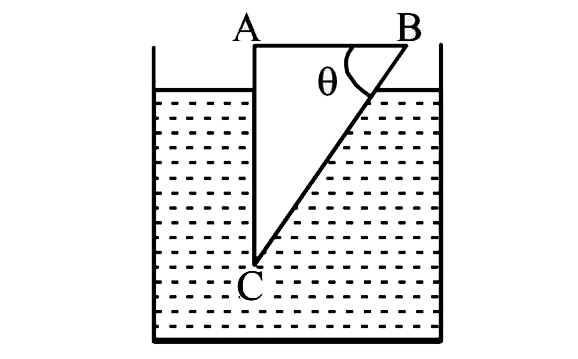
View SolutionIn Young's double-slit experiment, the separation between the slits is halved and the distance between the slits and the screen in doubled. The fringe width is
View Solution
A ray of light from a denser medium strike a rarer medium at an angle of incidence I (see Fig). The reflected and refracted rays make as angle of 90degrees with each other. The angles of reflection and refraction are r and `r` The critical angle is
View SolutionTwo coherent monochromatic light beams of intensities I and 4 I are superposed. The maximum and minimum possible intensities in the resulting beam are
View SolutionSpherical aberration in a thin lens can be reduced by
View SolutionA beam of light of wave length 600 nm from a distance source fall on a single slit 1mm wide and a resulting. Diffraction pattern is observed on a screen 2m away. The distance between the first dark fringes on either side of central bright fringe is
View Solution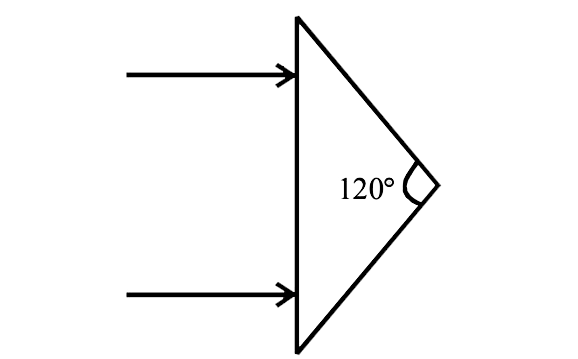
An isosceles prism of angle 120degree has a refractive index 1.44. Two parallel monochromatic rays enter the prism parallel to each other in air as shown. The rays emerge from the opposite faces
View SolutionA diminished image of an object is to be obtained on a screen 1.0 m from it. This can be achieved by appropriately placing
View SolutionThe focal length of the objective and the eye piece of a compound microscope are 2.0 cm and 3.0 cm, respectively. The distance between the objective and the eye piece is 15.0 cm. The final image formed by the eye piece is at infinity. The two lenses are thin. The distance in cm of the object and the image produced by the objective, measured from the objective lens, are respectively
View SolutionConsider Fraunhoffer diffraction pattern obtained with a single slit illuminated at normal incidence. At the angular position of the first diffraction minimum the phase difference (in radians) between the wavelets from the opposite edges of the slit is
View SolutionIn an interference arrangement similar to Young's double-slit experiment, the slits S_1 and S_2 are illuminated with coherent microwave sources, each of frequency 10^6 Hz. The sources are synchronized to have zero phase difference. The slits are separated by a distance d=150.0 m. The intensity I (theta) is measured as a function of theta, where theta is defined as shown. If I_0 is the maximum intensity, then I (theta) for 0lethetale90degree is given by

View SolutionA concave lens of glass, refractive index 1.5 has both surfaces of same radius of curvature R. On immersion in a medium of refractive index 1.75, it will behave as a
View SolutionYellow light is used in a single slit diffraction experiment with slit width of 0.6 mm. If yellow light is replaced by X-rays, then the observed pattern will reveal,
View SolutionA thin slice is cut out of a glass cylinder along a plane parallel to its axis. The slice is placed on a flat glass plate as shown in Figure. The observed interference fringes from this combination shall be

View SolutionA hollow double concave lens is made of very thin transparent material. It can be filled with air or either of two liquids L_1 or L_2 having refractive indices mu_1 and mu_2 respectively `(mu_2gtmu_1gt1)`. The lens will deverge a parallel beam of light if it is filled with
View SolutionA point source of light B is placed at a distance L in front of the centre of a mirror of width `d` hung vertically on a wall. A man walks in front of the mirror along a line parallel to the mirror at a distance 2L from it as shown in fig. The greatest distance over which he can see the image of the light source in the mirror is
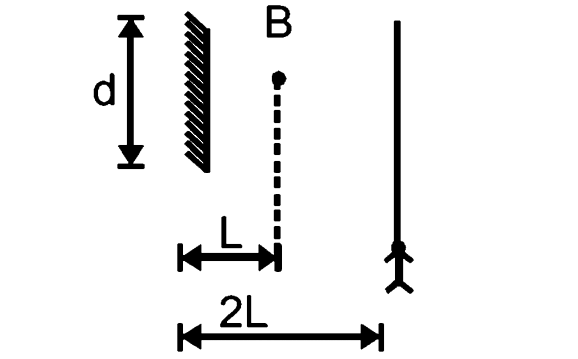
View Solution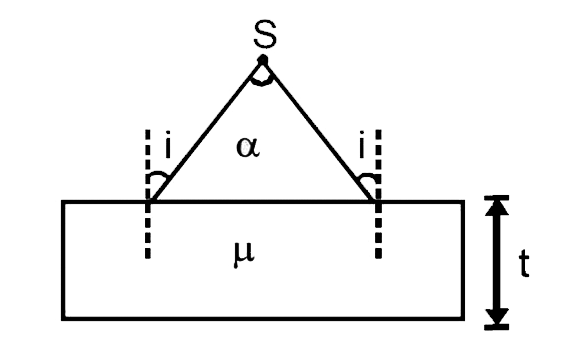
A diverging beam of light from a point source S having devergence angle `alpha`, falls symmetrically on a glass slab as shown. The angles of incidence of the two extreme rays are equal. If the thickness of the glass slab is t and the refractive index n, then the divergence angle of the emergent beam is
View SolutionA rectengular glass slab ABCD of refractive index n_1 is immersed in water of refractive index `n_2(n_1gtn_2)`. A ray of light is incident at the surface AB of the slab as shown. The maximum value of the angle of incidence `alpha_max` such that the ray comes out only from the other surface CD is given by

View SolutionIn a double slit experiment instead of taking slits of equal widths, one slit is made twice as wide as the other. Then, in the interference pattern
View SolutionIn a compound microscope, the intermediate image is
View SolutionTwo beams of ligth having intensities I and 4I interface to produce a fringe pattern on a screen. The phase difference between the beams is `(pi)/(2)` at point A and `pi` at point B. Then the difference between the resultant intensities at A and B is
View SolutionIn a Young's double slit experiment, 12 fringes are observed to be formed in a certain segment of the screen when light of wavelength 600nm is used. If the wavelength of light is changed to 400nm, number of fringes observed in the same segment of the screen is given by
View SolutionA ray of light passes through four transparent media with refractive indices`mu_1`,`mu_2`,`mu_3` and `mu_4` as shown in the figure. The surfaces of all media are parallel. If the emergent ray CD is parallel to the incident ray AB, we must have
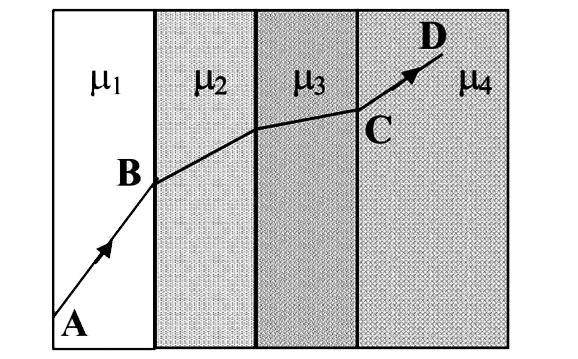
View SolutionA given ray of light suffers minimum deviation in an equilateral prism P. Additional prism Q and R of identical shape and of the same material as P are now added as shown in the figure. The ray will now suffer
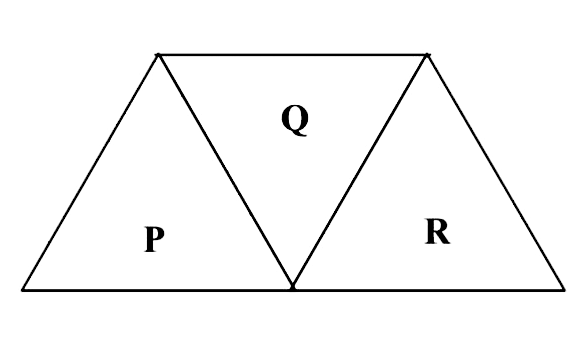
View SolutionAn observer can see through a pin-hole the top end of a thin rod of height h, placed as shown in the figure. The beaker height is 3h and its radius h. When the beaker is filled with a liquid up to a height 2h, he can see the lower end of the rod. Then the refractive index of the liquid is
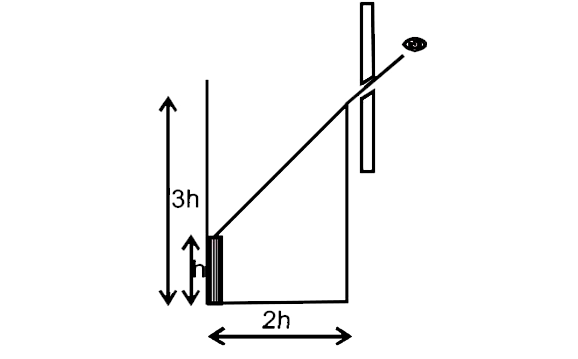
View SolutionWhich one of the following spherical lenses does not exhibit dispersion? The radii of curvature of the surfaces of the lenses are as given in the diagrams. `
View SolutionIn the ideal double-slit experiment, when a glass-plate(refractive index 1.5) of thickness t is introduced in the path of one of the interfering beams (wave-length `lamda`), the intensity at the position where the central maximum occurred previously remains unchanged. The minimum thickness of the glass-plate is
View SolutionTwo plane mirrors A and B are aligned parallel to each other, as shown in the figure. A light ray is incident at an angle 30degree at a point just inside one end of A. The plane of incidence coincides with the plane of the figure. The maximum number of times the ray undergoes reflections (including the first one) before it emerges out is
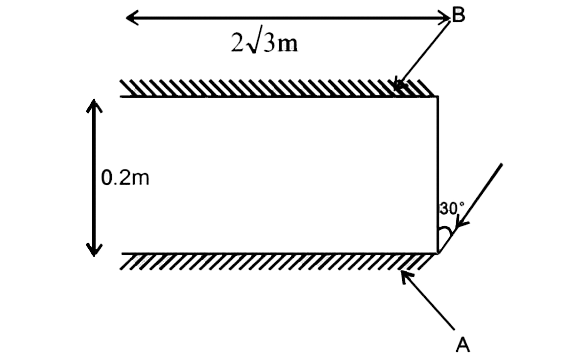
View SolutionIn the adjacent diagram, CP represents a wavefront and AO & BP, the corresponding two rays. Find the condition on `theta` for constructive interference at P between the ray BP and reflected ray OP.

View SolutionThe size of the image of an object, which is at infinity, as formed by a convex lens of focal length 30 cm is 2 cm. If a concave lens of focal length 20 cm is placed between the convex lens and the image at a distance of 26 cm from the convex lens, calculate the new size of the image
View SolutionA ray of light is incident at the glass-water interface at an angle I, it emerges fimally parallel to the surface of water, the the value of `mu_g` would be
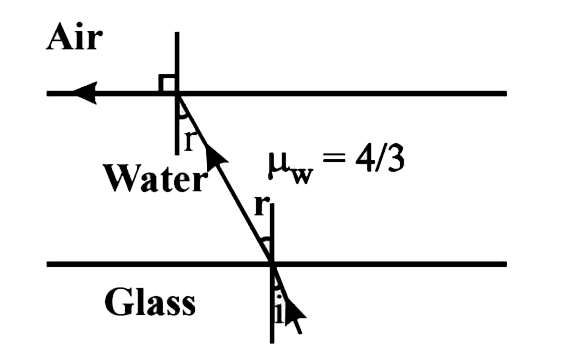
View SolutionA beam of white light is incident on glass air interface from glass to air such that green light just suffers total internal reflection. The colors of the light which will come out to air are
View SolutionAn equilateral prism is placed on a horizontal surface. A ray PQ is incident onto it. For minumum deviation,
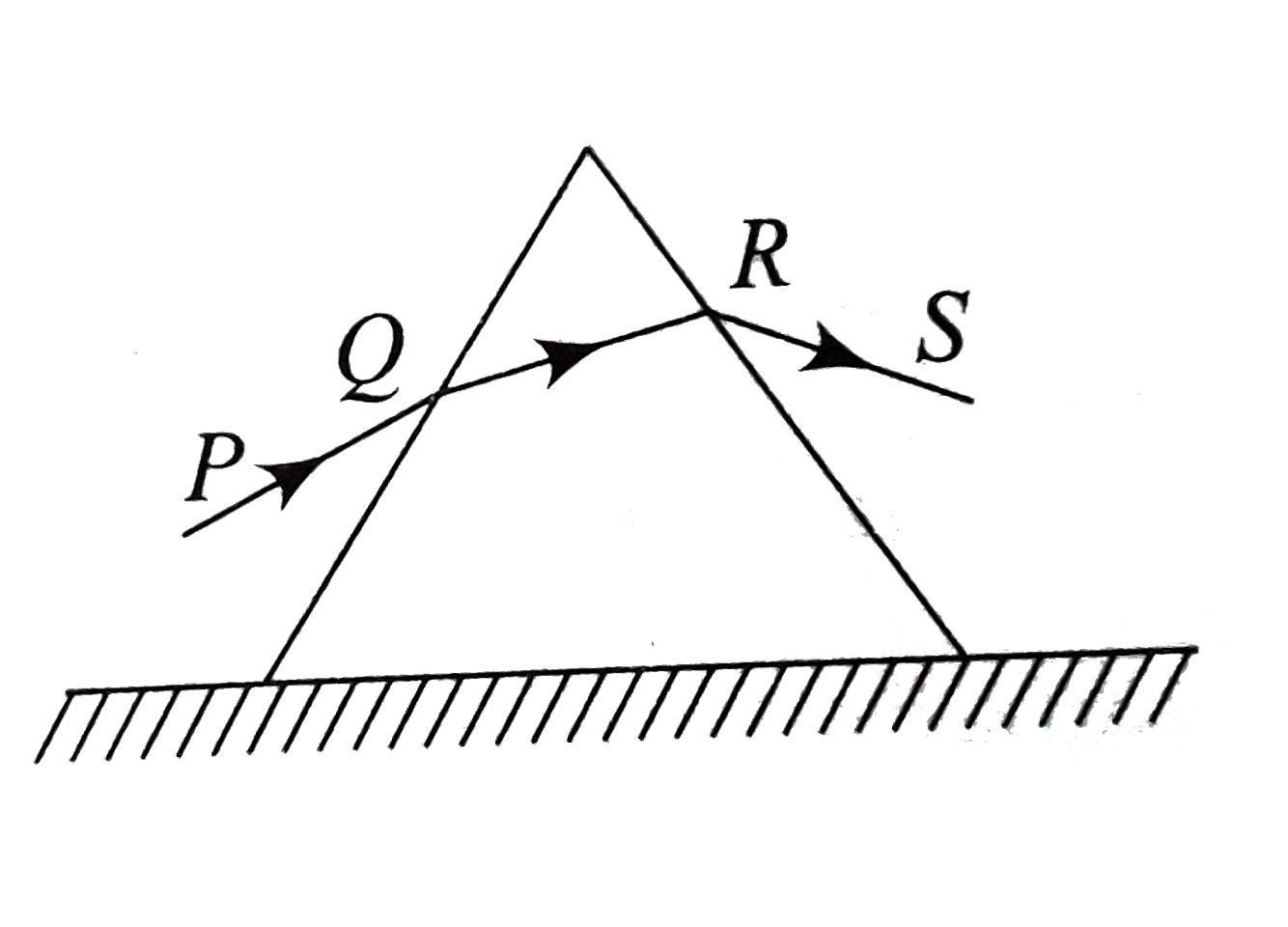
View SolutionMonochromatic light of walelength 400nm and 560nm are incident simultaneously and normally on double slits apparatus whose slit sepation is 0.1 mm and screen distance is 1m. Distance between areas of total darkness will be
View SolutionA source emits sound of frequency 600Hz inside water. The frequency heard in air will be equal to (velocity of sound in water`=1500(m)/(s)`, velocity of sound in air = `300(m)/(s)`
View SolutionA point object is placed at the centre of a glass sphere of radius 6cm and refractive index 1.5. The distance of virtual image from the surface is
View SolutionIn Young's double slit experiment intensity at a point is `((1)/(4))` of the maximum intersity. Angular position of this point is
View SolutionA convex lens if in contact with concave lens. The magnitude of the ratio of their focal length is `(2)/(3)`. Their equivalent focal length is 30 cm. What are their individual focal lengths?
View SolutionA container is filled with water `(mu=1.33)` upto a height of 33.25 cm. A concave mirror is placed 15cm above the water level and the image of an object placed at the bottom is formed 25 cm below the water level. Focal length of the mirror is
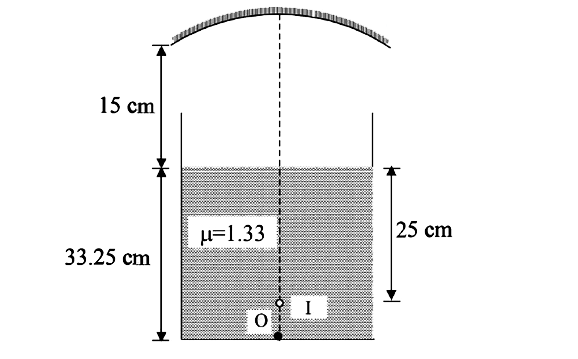
View SolutionFocal length of the plano-convex lens is 15 cm. A small object is placed at A as shown in the figure. The plane surface is silvered. The image will form at `
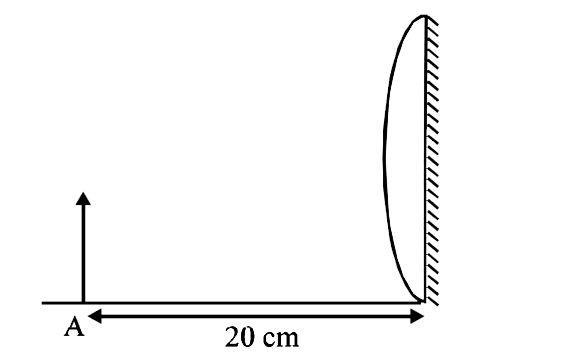
View SolutionThe graph shown relationship between object distance and image distance for a equiconvex lens. Then focal length of the lens is `
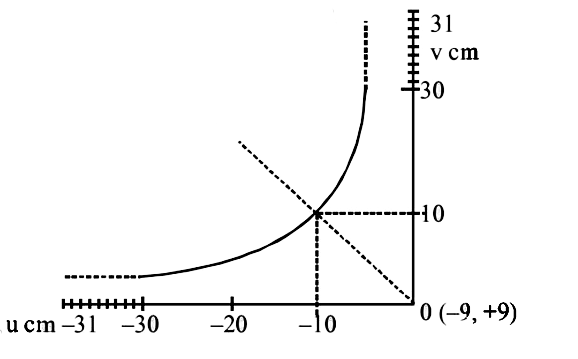
View SolutionRays of light from Sun falls on a biconvex lens of focal length f and the circular image of Sun of radius r is formed on the focal plane of the lens. Then
View SolutionIn an experiment to determine the focal length `(f)` of a concave mirror by the `u-v` method, a student places the object pin A on the principal axis at a distance x from the pole P. The student looks at the pin and its inverted image from a distance keeping his/her eye in line with PA. When the student shifts his/her eye towards left, the image appears to the right of the object pin. Then,
View SolutionA ray of light travelling in water is incident on its surface open to air. The angle of incidence is `theta`, which is less than the critical angle. Then there will be
View SolutionTwo beams of red and violet colours are made to pass separately through a prism (angle of the prism is ` 60degree`). In the position of minimum deviation, the angle of refraction will be
View SolutionA light beam is travelling from Region `I` to `IV` (figure). The refractive index in regionals `I,II,III` and `IV` are `n_0=(n_0)/(2), (n_0)/(6) and (n_0)/(8)` respectively. The angle of incidence `theta` for which the beam just misses entering region IV is- `
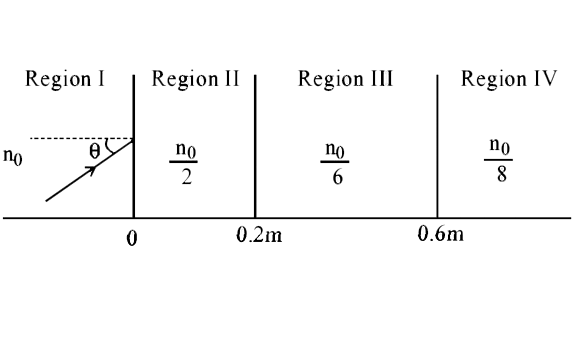
View SolutionA ball is dropped from a height of 20 m above the surface of water in a lake. The refractive index of water is 4.3. A fish inside the lake, in the line of fall of the ball, is looking at the ball. At an instant, when the ball is 12.8 m above the water surface, the fish sees the speed of the ball as `[Take _(g)=10m/s^(2).]`
View SolutionA biconvex lens of focal length 15 cm is in front of a plane mirror. The distance between the lens and the mirror is 10 cm. A small object is kept at a distance of 30 cm from the lens. The final image is
View SolutionA light ray travelling in glass medium is incident of glass- air interface at an angle of incidence `theta`. The reflected `(R )` and transmitted (T) intensities, both as function of `theta`, are plotted The correct sketch is
View SolutionA bi-convex lens is formed with two thin plano-convex lenses as shown in the figure. Refractive index n of the first lens is 1.5 and that of the second lens is 1.2. Both the curved surface are of the same radius of curvature R=14 cm. For this bi-convex lens, for an object distance of 40 cm, the image distance will be `

View SolutionYoung's double slit experiment is carried out by using green, red and blue light, one color at a time. The fringe width recorded are `b_(G)`,`b_(R)` and `b_(B)` respectively. Then,
View SolutionA ray of light travelling in the direction `(1)/(2)``(hati,+sqrt3hatj)` is incident on a plane mirror. After reflection, it travels along the direction `(1)/(2)` `(hati-sqrt3hatj)` . The angle of incidence is
View SolutionIn the Young's double slit experiment using a monochromatic light of wavelength `lamda`, the path difference (in terms of an integer n) corresponding to any point having half the peak
View SolutionA point source S is placed at the bottom of a tranparent block of height 10mm and refractive index 2.72. It is immersed in a lower refractive index liquid as shown in the figure. It is found that the light emerging from the block to the liquid forms a circular bright spot of diameter 11.54 mm on the top of the block. The refractive index of the liquid is `
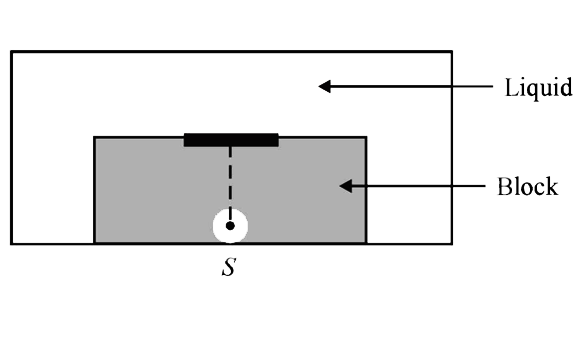
View SolutionA parallel beam of light is incident from air at an angle `alpha` on the side PQ of a right angled triangular prism of refractive index `n=sqrt2`. Light undergoes total internal reflection in the prism at the face PR when `alpha` has a minimum value of `45degree`.
The angle `theta` of the prism is `

View SolutionA small object is placed 50 cm to the left of a thin convex lens of focal length 30 cm. A convex spherical mirror of radius of curvature 100 cm is placed to the right of the lens at a distance of 50 cm. The mirror is tilted such that the axis of the mirror is at an angle `theta``=30degree` to the axis of the lens, as shown in the figure
If the origin of the coordinate system is taken to be at the centre of the lens, the coordinates (in cm) of the point `(x,y)` at which the image is formed are
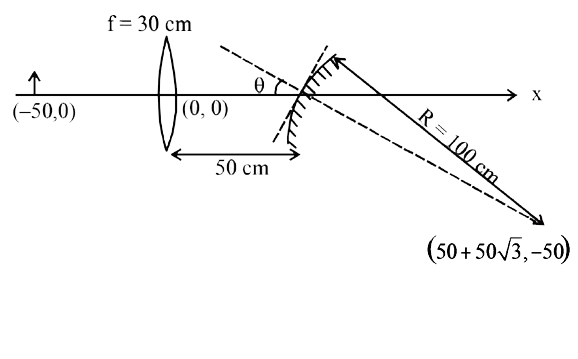
View SolutionIn the Young's double slit experiment, the interference pattern is found to have as intensity ratio between the bright and dark fringes as 9. This implies that
View SolutionA convex lens of focal length 40 cm is in contact with a concave lens of focal length 25 cm. The power of the combination is
View SolutionWhite light is used to illuminate the two slits in a Young's double slit experiment. The separation between the slits is b and the screen is at a distance d`(gtb) from the slits. At a point on the screen directly in front of one of the slits, certain wavelength are missing. Some of these missing wavelength are
View SolutionA converging lens is used to form an image on a screen. When the upper half of the lens is covered by an opaque screen
View SolutionA short linear object of length b lies along the axis of a concave mirror of focal length f at a distanee u from the pole of the mirror. The size of the image is approximately equal to
View SolutionA beam of light consisting of red, green and blue colours is incident on right angled prism. The refractive indices of the material of the prism for the above red, green and blue wavelengths are `1.39,1.44 and 1.47` respectively. The prism will.
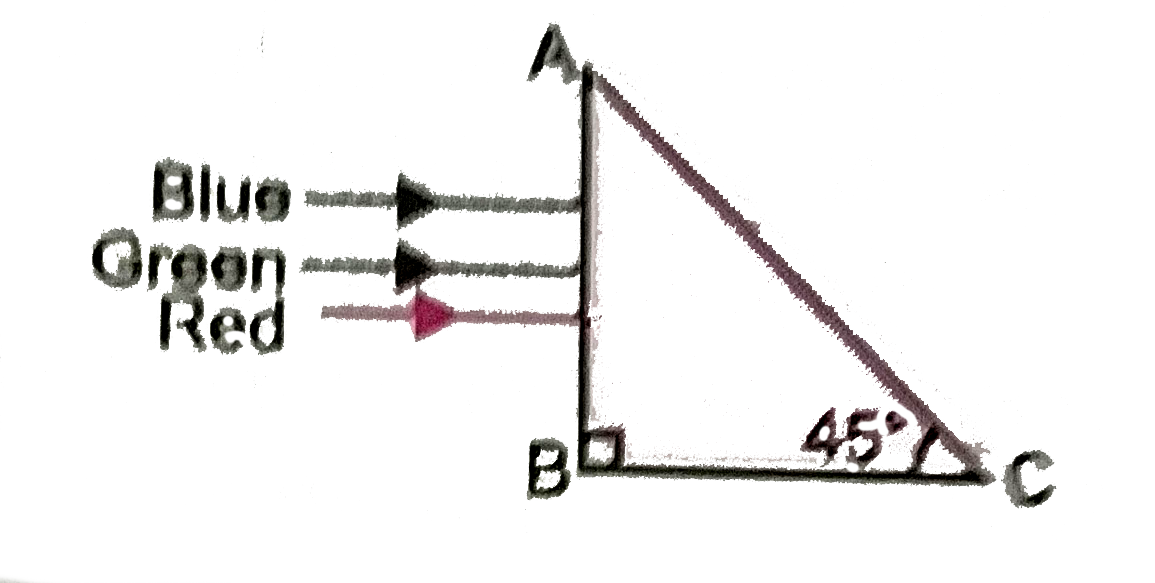 .
.
View SolutionAn astronomical telescope has an angular magnification of magnitude 5 for distant object. The separation between the objective and the eyepiece is 36 cm and the final image is formed at infinity. The focal length `f_(0)` of the objective and the focal length `f_(0)` of the eyepiece are
View SolutionA thin prism `P_(1)` with angle `4degree` and made from glass of refractive index 1.54 is combined with another thin prism `P_(2)` made from glass of refractive index 1.72 to produce dispersion without deviation. The angle of the prism `P_(2)` is
View SolutionA planet is observed by astronomical refracting telescope having an objective of focal length 16cm and an eyepiece of focal length 2cm.
View SolutionTwo thin convex lenses of focal lengths `f_(1)` and `f_(2)` are separated by a horizontal distance d (where`dltf_(1)`,`dltf_(2)`) and their centres are displaced by a vertical separation `triangle` as shown in the fig.
Taking the origin of coordinates O, at the centre of the first lens the x and y coordinates of the focal point of this lens system, for a parallel beam of rays coming form the left, are given by: `
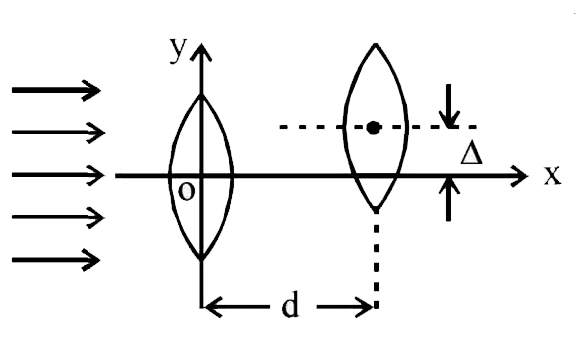
View SolutionWhich of the following form(s) a virtual and erect image for all position of the object?
View SolutionA real image of a distant object is formed by a plano-convex lens of its principal axis. Spherical aberration
View SolutionA ray of light travelling in a transparant medium falls on a surface separating the medium from air at an angle of incidence of `45degree`. The ray undergoes total internal reflection. If n is the refractive in index of the medium with respect to air, select the possible value (s) of n from the following:
View SolutionA parallel monochromatic beam of light is incident normally on a narrow slit. A diffraction pattern is formed on a screen placed perpendicular to the direction of the incident beam. At the first minimum of the diffraction pattern, the phase difference between the rays coming from the two edges of the slit is
View SolutionA concave mirror is placed on a horizontal table, with its axis directed vertically upwards. Let O be the pole of the mirror and C its centre of curvature. A point object is placed at C. It has a real image, also located at C. If the mirror is now filled with water, the image will be.
View SolutionA spherical surface of radius of curvature R separates air (refractive index 1.0) from glass (refractive index 1.5). The centre of curvature is in the glass. A point object P placed in air is found to have a real image Q in the glass. The line PQ cuts the surface at a point O, and `PO=OQ`. The distance `PO`
View SolutionIn a Young's double slit experiment, the separation between the two slits is d and the wavelength of the light is `lamda`. The intensity of light falling on slit 1 is four times the intensity of light falling on slit 2. Choose the correct choice (s).
View SolutionA student performed the experiment of determination of focal length of a concave mirror by `u-v` method using an optical bench of length 1.5 meter. The focal length of the mirror used is 24 cm. The maximum error in the location of the image can be 0.2 cm. The 5 sets of `(u,v)` values recorded by the student (in cm) are: `(42,56),(48,48),(60,40),(66,33),(78,39)` . The data set (s) that cannot come from experiment and is (are) incorrectly recorded, is (are)
View SolutionA ray OP of monochromatic light is incident on the face AB of prism ABCD mear vertex B at an incident angle of `60degree` (see figure). If the refractive index of the material of the prism is `sqrt3`, which of the following is (are) are correct? `
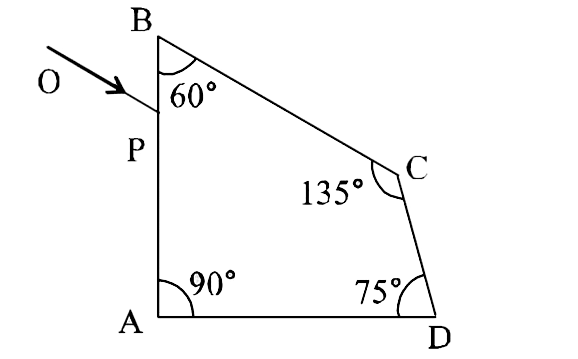
View SolutionA transparent thin film of uniform thickness and refractive index `n_(1)``=1.4` is coated on the convex spherical surface of radius R at one end of a long solid glass cylinder of refractive index `n_(2)``=1.5`, as shown in the figure. Rays of light parallel to the axis of the cylinder traversing through the film from air to glass get focused at distance `f_(1)` from the film, while rays of light traversing from glass to air get focused at distance `f_(2)` from the film, Then `
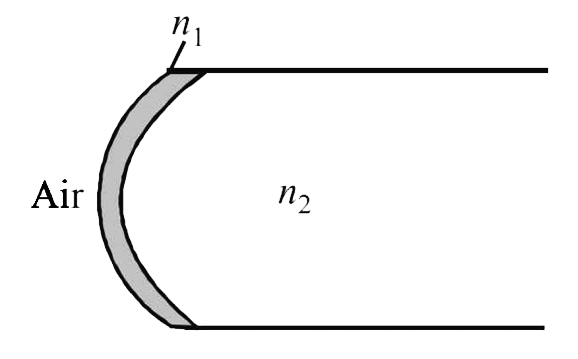
View SolutionA light source, which emits two wavelength `lamda_(1)=400nm` and `lamda_(2)=600nm`, is used in a Young's double slit experiment. If recorded fringe width for `lamda_(1)` and `lamda_(2)` are `beta_(1)` and `beta_(2)` and the number of fringes for them within a distance y on one side of the central maximum are `m_(1)` and `m_(2)` respectively, then
View SolutionTwo identical glass rods `S_(1)` and `S_(2)` (refractive index=1.5) have one convex end of radius of curvature 10 cm. They are placed with the curved surfaces at a distance d as shown in the figure, with their axes (shown by the dashed line) aligned. When a point source of light P is placed inside rod `S_(1)` on its axis at a distance of 50 cm from the curved face, the light rays emenating from it are found to be parallel to the axis inside `S_(2)`. The distance d is
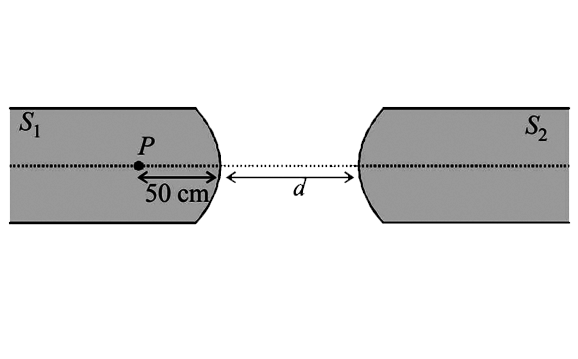
View Solution
JEE Main And Advanced questions and complete solutions for chapter RAY AND WAVE OPTICS of SUNIL BATRA 41 YEARS IITJEE PHYSICS (HINGLISH) of Class 12